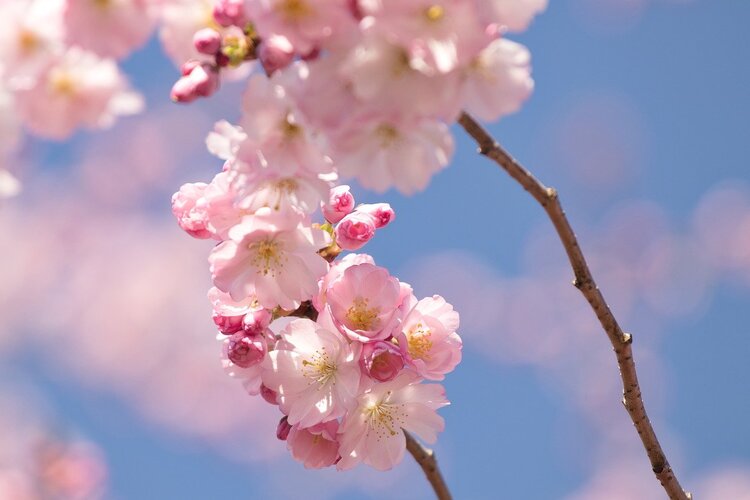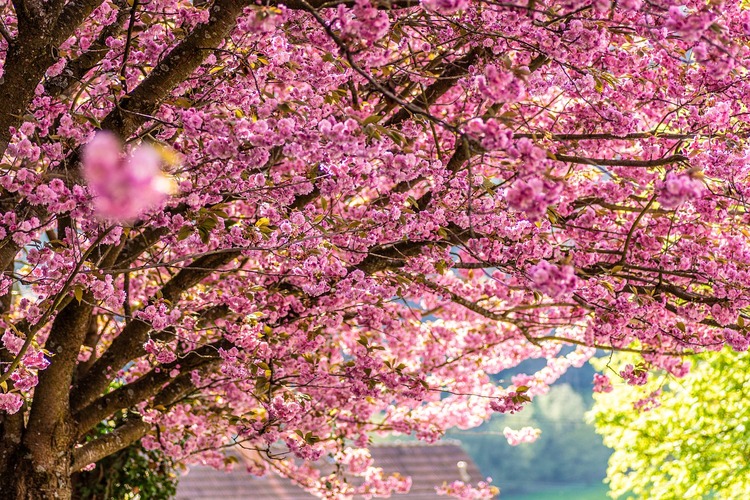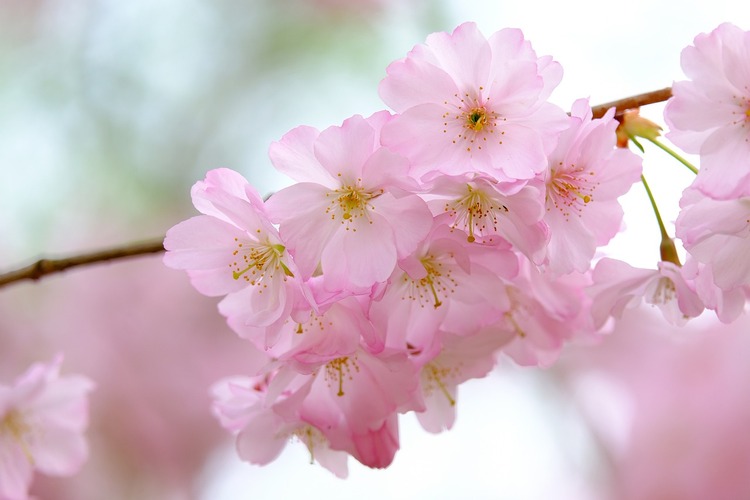What does Sakura tea taste like?
Sakura tea is derived from the beautiful cherry blossoms, or sakura, which bloom briefly every spring.
As you take your first sip of sakura tea, you’ll be greeted by a gentle floral taste brought to life by the flower’s petals. Also, the tea offers a gentle sweetness and a hint of earthiness. It evokes the feeling of a springtime breeze in a Japanese garden, with a slightly astringent quality reminiscent of green tea.
Keep reading to learn more about this tea enjoyed during traditional Japanese tea ceremonies and other special celebrations.
Please note: This article contains affiliate links, meaning I may earn a commission if you make a purchase by clicking a link. Of course, this comes at no extra cost to you and helps me keep offering readers solid information.

What is Sakura Tea?
Sakura tea, also known as “Sakura-cha” or “Sakurayu,” is a flavorful herbal tea from Japan. It’s derived from the beautiful cherry blossoms, or sakura flowers, that adorn the cherry blossom trees in East Asia. This tea is pleasing to the eye and offers a delightful taste and aroma.
As a tea lover, you might be familiar with the mesmerizing sight of cherry blossom trees in full bloom. However, you may need to be aware that the delicate sakura flowers and leaves can be transformed into a delightful cup of tea. Sakura tea is an essential part of Japanese culture and is commonly enjoyed during special occasions and celebrations.
Sakura flowers are preserved for tea meticulously, maintaining their delicate appearance and flavor. Here’s a general overview of how this preservation is typically done:
- Harvesting: Sakura flowers are carefully handpicked during the cherry blossom season when they are in full bloom. The timing is crucial as the petals must be fresh at their peak.
- Blanching: The harvested flowers are briefly blanched in boiling water. This step helps remove any impurities, such as insects or dust and sets the color of the blossoms.
- Drying: After blanching, the flowers are dried in a shaded and well-ventilated area. This slow-drying process helps preserve the delicate color and flavor of the blossoms while reducing moisture content.
- Salt Treatment: The dried blossoms are traditionally salted or pickled in a saltwater solution to preserve the flowers further and enhance their flavor. This step acts as a preservative and imparts a subtle salty-sweet flavor to the blossoms.
- Packaging: Once the Sakura flowers are adequately dried and salted, they are carefully packaged and sealed to protect them from moisture and contaminants. Some are packaged individually for later use in tea, while others might be used for culinary purposes.
When you’re ready to brew a cup of sakura tea, simply add hot water to the preserved flowers and enjoy this exquisite tea’s fragrant, subtle, and slightly salty flavor.
What Does Sakura Tea Taste Like?
Sakura tea has a flavor profile that might surprise your taste buds. It is a delightful blend of sweet and salty, making it unlike any other tea you may have sampled before.
The main element of sakura tea’s taste comes from its core ingredient: cherry blossom, or sakura, flowers. These delicate flowers impart a light, floral taste to the tea, resembling cherry-flavored things but with a subtle twist. One of the things you might notice as you take your first sip is the hint of sweetness that lingers on your palate.
The sweet taste of sakura tea is often balanced by a touch of saltiness, which is introduced by preserving the cherry blossoms in salt. This slight saltiness adds another layer of complexity to the tea’s flavor, making it enchanting for tea lovers to explore.
It’s important to remember that each sakura tea blend might have nuances. Factors like the quality of cherry blossoms used, the preservation process, and the type of tea leaves blended with the blossoms contribute to these subtle differences in taste.

Process of Making Sakura Tea
Making sakura tea is an enjoyable process, and you’ll love the unique taste it offers. First things first, gather your ingredients. You’ll need:
- Sakura flowers (preferably pickled)
- Hot water
- Optional: sakura leaf or sakura sencha
Step 1: You’ll start by preparing the pickled sakura flowers. If you don’t have them pre-pickled, you can pickle them yourself. Gently wash the fresh sakura flowers and remove their black calyces. Soak the flowers in a pickling solution made of salt and plum vinegar. Make sure they’re fully covered for at least 3 days, after which they should have absorbed the flavors and have a slightly salty taste. Store the pickled flowers in the refrigerator.
Step 2: When ready to make your sakura tea, take a pickled sakura flower and rinse it with cold water to remove saltiness. Next, place the flower in your teacup.
Step 3: Boil water and let it cool down slightly before pouring it over the sakura flower. Filling your tea cup with hot water will allow the flower to unfurl and release its lovely aroma and delicate flavor.
Step 4: For a different variation of the tea, you can add a sakura leaf or sakura sencha (green tea with sakura flavor) to your cup before pouring the hot water. This will give the tea a slightly different taste with the added depth of the tea leaves or sencha.
Now, let your sakura tea steep for a few minutes, and then enjoy the beautiful taste of the cherry blossoms.
Food Pairings
You can enhance the experience by pairing it with various foods when enjoying sakura tea. You’ll find that many pastries, snacks, and sweets perfectly complement the tea’s floral notes and delicate flavors.
Mochi, a traditional Japanese rice cake, pairs excellently with sakura tea. The chewy texture and mild mochi flavor allow your taste buds to appreciate the nuanced fragrance of the tea. Often filled with red bean paste or anko (sweetened and mashed red beans), mochi complements the sakura tea’s unique taste.
Including honey as a sweetener or an accompaniment with your sakura tea heightens its floral undertones and brings out its subtle flavors. A small dollop on your tea or drizzled over some snacks creates an exquisite and harmonious taste profile.
Red bean paste, or anko, is a particularly satisfying pairing for this tea. Both red bean paste-filled pastries and dishes featuring red beans as a central ingredient work well, allowing the sweet yet earthy red bean taste to be accentuated by the cherry blossom fragrance of the tea.
Sakura mochi, a distinctive Japanese sweet made with glutinous rice and red bean paste wrapped in a pickled sakura leaf, naturally complements the tea. Combining these sweet and delicate flavors highlights the harmony between food and drink.
Lighter options, such as rice crackers and Japanese sweets, are more suitable when choosing snacks to accompany your sakura tea. These low-intensity flavors allow for the delicate and floral attributes of the tea to shine through without being overpowered.

Health Benefits of Sakura Tea
Sakura tea has various health benefits that can improve your well-being.
One key element of sakura tea is its antioxidant content, which can help fight off free radicals in your body. Antioxidants are essential in maintaining a healthy immune system and protecting your cells from damage. Incorporating sakura tea into your routine can give your body an antioxidant boost.
In addition to antioxidants, sakura tea offers anti-inflammatory properties. If you have arthritis, joint pain, or other inflammatory conditions, drinking sakura tea may help alleviate discomfort by reducing inflammation. This makes it a fantastic option for those seeking natural ways to manage their symptoms.
Another advantage of sakura tea is its potential to help with blood pressure regulation. Regularly drinking sakura tea may lower blood pressure levels, reducing the risk of heart disease and stroke.
For those who practice meditation or mindfulness, drinking sakura tea can complement your practice. The tea’s calming and soothing properties can help you achieve a peaceful state of mind and promote overall relaxation.
Buying Recommendations
If you are thinking about buying Sakura ingredients online, please take into consideration the following recommendations:
NESTLADY Edible Salt Pickled Sakura


Sakura Japanese Loose Leaf Black Tea

Frequently Asked Questions
What is the flavor profile of Sakura tea?
Sakura tea has a delicate and subtle floral taste hinting of a cherry blossom aroma. When you first sip Sakura tea, you will experience a mild sweetness followed by a slight tartness. It’s a perfect tea for those who appreciate nuanced flavors and refreshing sensations.
How would you describe the taste of salted Sakura tea?
Salted Sakura tea, also known as Sakura no shio-cha, has a more complex flavor profile than unsalted varieties. The saltiness in the tea brings out the floral taste and adds a savory note to the drink. This unique balance of sweet, salt, and tart makes salted Sakura tea an exciting and sophisticated choice for tea lovers.
Are there different varieties of Sakura tea?
Indeed, several varieties of Sakura tea are available, all made from different blends of cherry blossom petals or leaves. Some of these varieties include:
- Salted Sakura tea: Also known as Sakura no shio-cha, this tea uses salt-preserved cherry blossom petals.
- Sweet Sakura tea: This version typically uses sweetened cherry blossom petals mixed with green or black tea.
- Sakura milk tea: It’s a blend of Sakura tea with milk and sometimes whipped cream, giving the tea a creamy texture.
What makes Lipton’s Sakura tea unique?
Lipton’s Sakura tea stands out because it blends high-quality green tea with cherry blossoms and other natural flavors. This blend highlights the cherry blossom’s unique flavor while providing a refreshing and uplifting green tea experience.
Does sweet Sakura tea have a distinct taste?
Sweet Sakura tea has a distinct taste, with an enhanced sweetness compared to unsalted varieties. The sugar used in the sweetening process adds depth and richness to the tea, making it a delightful option for people looking for a more dessert-like tea experience.
Is there a noticeable difference between Sakura tea and Sakura milk tea?
Yes, there is a noticeable difference between Sakura tea and Sakura milk tea. While Sakura tea has a light, delicate flavor with a floral fragrance, Sakura milk tea has a richer, creamier texture due to the addition of milk. The milk adds a smooth and velvety mouthfeel to the tea, often resulting in a more comforting and indulgent drink.

I hope you have enjoyed the article!
Have you tried this tea?